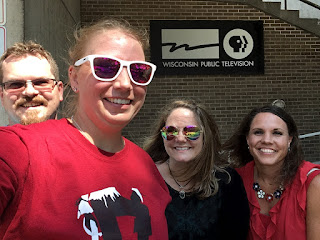Visiting Student Internship-Restoring Flow to the Mukwonago River Watershed
.JPG) Every summer the Nature Conservancy offers paid student internships for Sophomores and Juniors in high school. In the past Kettle Moraine has had quite a few students participate. This year one of my AP Environmental students was fortunate to receive 1 of 4 internships offered to students in the area. I thought what a great opportunity it would be for me to visit this student during her internship and to see what types of projects they were up to this summer, so I arranged a morning to tag along. She told me what time and where to meet and I was to show up and be prepared to work. I didn't think it was important to ask what we were going to be doing, because I was there for the experience. I also wanted to be able to check out the Nature Conservancy facility to see if it was somewhere that would accommodate our class for field trips.
Every summer the Nature Conservancy offers paid student internships for Sophomores and Juniors in high school. In the past Kettle Moraine has had quite a few students participate. This year one of my AP Environmental students was fortunate to receive 1 of 4 internships offered to students in the area. I thought what a great opportunity it would be for me to visit this student during her internship and to see what types of projects they were up to this summer, so I arranged a morning to tag along. She told me what time and where to meet and I was to show up and be prepared to work. I didn't think it was important to ask what we were going to be doing, because I was there for the experience. I also wanted to be able to check out the Nature Conservancy facility to see if it was somewhere that would accommodate our class for field trips.When I arrived, I was informed that we were going to be visiting the Meyer Preserve to pull out a drainage ditch that was installed 50+ years ago by the previous owner of the land. We all piled up in the pickup and headed to the preserve. The purpose of our project was to restore flow to a section of the Mukwonago River on the property where this drainage ditch was installed. I was informed that we were going to be walking through wetlands and that we would be wearing waders. What I didn't realize was how uncomfortable those were to wear and walk about 1/4 mi to the work site. While walking there I may have gotten stuck a few times in the muck and struggled to lift my feet up over fallen tree logs. I was quickly reminded of the time in college while forging a creek when I got stuck in the sediment. The strategy was to keep moving and not stop. We had to cross through a shrubby edge to get to the wetland, and then finally the river. The best strategy was walking backwards so that the shrubbery didn't snap back and hit you in the face.
Upon arriving at the work site there was about an 8 ft. drainage pipe that was cleared off. We got to work and started digging out all of the foliage, roots, and sediment around the pipe. We had a pick axe and various shovels to do the job. What we didn't realize is there was a second portion that had broken off and the drainage pipe actually ran about 20ft. This wasn't what we were expecting. While we were out there, we saw a viceroy, leeches, a snake, various frogs, and types of vegetation. I joined the team until lunch and the final picture below is where we left off. I got an email from my student later that afternoon informing me that they succeeded and got the whole pipe out in its entirety. There was a lot of sweat and blisters formed as a result of this project.
.JPG) I can't imagine a better way for students to learn and experience environmental stewardship. While working I asked the students what they've gotten to do so far this year, what were some of their favorite and least favorite activities? One of their favorites was doing a quadrat study, while a least favorite pulling sweet clover (all day). If anything from this opportunity students are more aware of what's around them. I wish all students had this opportunity in their educational programs.
I can't imagine a better way for students to learn and experience environmental stewardship. While working I asked the students what they've gotten to do so far this year, what were some of their favorite and least favorite activities? One of their favorites was doing a quadrat study, while a least favorite pulling sweet clover (all day). If anything from this opportunity students are more aware of what's around them. I wish all students had this opportunity in their educational programs.

.JPG)
.JPG)


.JPG)
Comments
Post a Comment